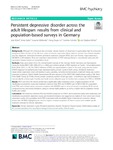Persistent depressive disorder across the adult lifespan: results from clinical and population-based surveys in Germany
Nübel, Julia
Guhn, Anne
Müllender, Susanne
Le, Hong Duyen
Cohrdes, Caroline
Köhler, Stephan
Background
Although the individual and economic disease burden of depression is particularly high for long-term symptoms, little is known of the lifetime course of chronic depression. Most evidence derives from clinical samples, and the diagnostic distinction between persistent depressive disorder (PDD) and non-chronic major depression (NCMDD) is still debated. Thus, we examined characteristics of PDD among clinical vs. non-clinical cases, and the associated disease burden at a population level.
Methods
Data were drawn from the mental health module of the German Health Interview and Examination Survey for Adults (DEGS1-MH, 2009–2012, n = 4483) and a clinical sample of PDD inpatients at Charité – Universitätsmedizin Berlin (2018–2019, n = 45). The DSM-5 definition of PDD was operationalized a priori to the study using interview-based DSM-IV diagnoses of dysthymia and major depression lasting at least 2 years in both surveys. Additional depression characteristics (depression onset, self-classified course, suicidality, comorbid mental disorders, treatment history and current depressive symptoms [Patient Health Questionnaire-9]) were assessed. In the DEGS1-MH, health-related quality of life (Short Form Health Survey-36, SF-36), chronic somatic conditions, number of sick days (past 12 months) or days with limitations in normal daily life activities (past 4 weeks), and health service utilization (past 12 months) were compared for PDD vs. NCMDD.
Results
PDD cases from the clinical sample had a significantly earlier depression onset, a higher proportion of self-classification as persistent course, and treatment resistance than PDD and NCMDD cases in DEGS1-MH. At a population level, PDD cases showed worse outcomes compared with NCMDD cases in terms of somatic comorbidity, SF-36 mental component score, and activity limitations owing to mental health problems, as well as a higher risk for outpatient mental health care contact.
Conclusions
The distinction between PDD and NCMDD proposed for DSM-5 seems warranted. Early onset depression, self-classification as persistent depressive course, and treatment resistance are suggested as markers of more severe and chronic depression courses. At a population level, PDD is associated with remarkably higher individual and economic disease burden than NCMDD, highlighting the need to improve medical recognition of chronic courses and establish specific treatment concepts for chronic depression.
Dateien zu dieser Publikation

